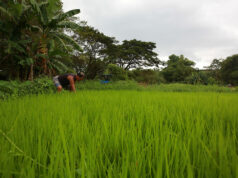Inflation rate expected to stay elevated
By Melissa Luz T. Lopez
Senior Reporter
and Elijah Joseph C. Tubayan
Reporter
INFLATION in the last two months of the year could match October’s pace, a senior official of the Bangko Sentral ng Pilipinas (BSP) said late last week, citing pressure from higher oil and power costs.
BSP Deputy Governor Diwa C. Guinigundo said the pace of overall price increases would likely hover above three percent in November and December near last month’s 3.5%.
“Our forecasts for the last two months are basically stable at around this level, but there are upside risks,” Mr. Guinigundo told reporters.
Commodity prices went up by 3.5% last month, picking up from the 3.4% climb logged in September and 2.3% in October 2016, the Philippine Statistics Authority said. This is the fastest monthly reading since 3.7% in November 2014.
Rising electricity and petroleum prices could stoke inflation, the central bank official said, noting that its impact could spill over to other basic goods and services.
“As we have seen how prices of petroleum have, in the past, would also drive the transport sector to seek adjustments in the charges on transport services,” Mr. Guinigundo said.
Retail pump prices increased by P0.90 per liter for gasoline, P0.75 for diesel and P0.55 per liter in kerosene on Nov. 7 as Dubai crude rose by roughly $2.70 a barrel, according to the Department of Energy’s oil monitor.
Separately, power distributor Manila Electric Co. announced that rates will rise by PhP0.3436 per kilowatt-hour due to a higher generation charge. Pending petitions for additional adjustments in utility rates are also in the horizon, Mr. Guinigundo said.
The BSP expects full-year inflation to average 3.2%, jumping from last year’s 1.8% but still within the 2-4% target band. As of the Nov. 9 meeting of the Monetary Board, oil prices assumptions were pegged at $52.70 per barrel for 2017, $56.33 for 2018, and $54.55 in 2019.
“There’s a decline in 2019 because we expect that US shale oil production will rebound,” Mr. Guinigundo said, even as he noted that an extension of production cuts among members of the Organization of the Petroleum Exporting Countries could drive crude prices even higher.
The central bank monitors inflation dynamics in deciding on monetary policy. The Monetary Board opted to keep interest rates unchanged during their meeting earlier this month, with inflation seen manageable and domestic demand still robust.
RATE HIKE PRESSURE RISING
For the Organization for Economic Cooperation and Development (OECD), it may just be a matter of time before the BSP finally raises benchmark rates.
Kensuke Tanaka, who heads the OECD Development Center’s Asia Desk, said that in the wake of the US Federal Reserve’s widely expected policy tightening in December — the third for this year — the BSP may follow suit.
“At the moment, the Philippines is a country that has a relatively high inflationary pressure among ASEAN (Association of Southeast Asian Nations), so I think that judging from the current situation at the moment, the central bank is relatively keen on a similar stance,” said Mr. Tanaka, in an interview on the sidelines of the ASEAN Business and Investment Summit in Solaire Resort & Casino in Parañaque City last week.
“Also judging from the current interest rate, the government has a room to increase. After the US, in the future, there is a possibility to increase.”
The Philippines has contributed to a general picture of rising inflation in Southeast Asia’s bigger economies, clocking 3.1% as of September (picking up to 3.2% in the 10 months to October after that month’s three-year-high 3.5%) against the BSP’s 3.2% full-year forecast average for 2017, as well as Malaysia’s 4.0%, Indonesia’s 3.9% and Vietnam’s 3.4% for the same nine months, according to OECD’s Economic Outlook for Southeast Asia, China and India 2018 report.
The BSP’s Monetary Board (MB) has kept its policy stance unchanged since September 2014, save for procedural cuts introduced in June last year for the shift to an interest rate corridor scheme designed to better siphon excess liquidity and influence market rates. Policy rates stayed at 3.5% for overnight lending, 3.0% for overnight reverse repurchase rate, and 2.5% for overnight deposits in the Nov. 9 meeting of the MB, which will review rates for the last time this year on Dec. 14.
Mr. Tanaka added that “[i]nflationary pressure… does not appear only in headline but (also) in core inflation.” Core inflation, which strips out volatile food and energy, edged up to 3.2% in October from the year-ago 2.3%, though the latest reading eased from September’s 3.3%. Year-to-date core inflation clocked 2.9% against the 1.9% recorded in 2016’s corresponding 10 months.
In late September, Fitch Group’s BMI Research said it expected a 25-basis point (bp) increase to 3.25% in benchmark overnight reverse repurchase rate “before the end of the year” and another increase of similar magnitude in 2018, while S&P Global Ratings said it sees a total of 75 bp increase to 3.75% by the end of 2018, rising further to 4.25% in 2019 and resting at that level the following year.
The OECD forecasts 6.6% gross domestic product growth for the Philippines this year, slower than the 6.9% expansion actually logged last year, against the government’s 6.5-7.5% target. It also expects economic growth to average 6.4% from 2018 to 2022, versus the government’s 7-8% annual target for the same period.



